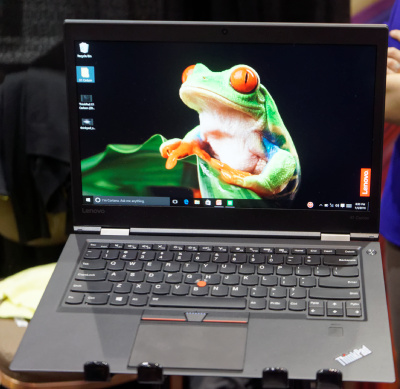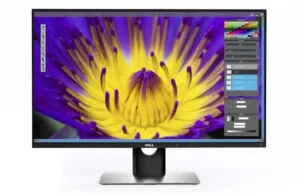One of the jobs that we commentators on the technology world have to do is to watch for inflection points – those moments in time when things change and are not the same again afterwards. We detected one of those for OLEDs at CES.

The big news was the announcement of notebooks with OLED displays from Lenovo, HP, Dell and Samsung (although the Samsung might be called a convertible or tablet). The slightly less big news (and only slightly) was the announcement of an OLED monitor from Dell. Let’s look at the notebooks first.
 Lenovo’s X1 Yoga OLED notebook has very saturated colours, especially for a notebook! Image: Meko Ltd
Lenovo’s X1 Yoga OLED notebook has very saturated colours, especially for a notebook! Image: Meko Ltd
In October 2003, Barry Young, then of DisplaySearch and these days from the OLED Association, said that the “killer app” for OLED was portable DVD players. When you see the technology in that application, he said, it means that it is ready for volume. Portable DVD players have more or less disappeared as a volume category, but at the time, the smartphone market didn’t exist, nor had Apple ignited the tablet market by developing the iPad.
The reasons that OLED might have been a good choice for a DVD player were that OLEDs didn’t have the response time or viewing angle problems that LCDs had. Further, Young (and the rest of us) thought that they should be a lot thinner and lighter and there was the possibility of power saving. These were all advantages in this application.
As it turned out, it has taken a lot longer to develop larger OLEDs than expected and the smartphone came along as an application to drive OLED volume. The problems that Kodak found early on in depositing OLED materials using a fine metal mask (FMM – as used by Samsung, the supplier of the OLEDs for all of these new products) have turned out to be very difficult to overcome and that has meant a problem in extending OLEDs of this type into large sizes.
The alternative technology for making OLEDs, that avoids the need for FMM patterning and was also developed by Kodak, uses unpatterned layers of OLED material that combine to form white light, and then filters that white light to isolate red, green and blue. LG uses this method to make its OLED TVs. However, this method uses at least three times more energy than the patterning method, so it should work for static, mains-powered sets, but not for mobile applications where battery life and weight are so critical.
On the other hand, OLEDs look really good because of the very deep black levels. I saw all of the OLEDs at CES and they all looked great. They are also very thin, with wide viewing angles and great colour. So what’s the downside to using them in portable displays? Well, that’s an issue of cost and power. The notebooks that have OLED as an option are all more expensive than the LCD alternative, where available. We heard that typical user extra cost is around $200. Given that the OEM cost of a 13.3″ notebook LCD panel starts at $30 or less (depending on precise specification), you can see that OLEDs must cost a fair bit more.
There is also a downside in power consumption. OLEDs can use less energy than LCDs when video, or mainly dark, content is being displayed. As Larry Weber established in his research on power use in plasmas, TV programmes rarely use more than 30% of the available maximum brightness (averaged over the screen) and movies are often in the 15% to 20% range. In that situation, the OLED works well. In IT applications, however, bright white screens are common and here OLEDs can take more power than LCDs.
As a result, all the notebook vendors are admitting that their OLED versions have shorter battery life, although it’s hard to get a clear picture at this stage as it depends how the battery life is measured. We heard numbers from 30 minutes to two hours at CES. Still, it’s great to see some competition for LCD in the notebook market.
Dell’s UP3017Q OLED monitor is only for specialists, at $4,999! The 32″ UltraHD LCD is currently $1,599. Image:Dell
The Dell monitor is less of an inflection point. Although it is the first intended for desktop IT use (other large OLED monitors, such as Sony’s, are aimed at broadcast), at $4,999, the 30″ UltraHD unit remains a firmly niche product. However, it could have a big impact on other brands in the content creation business, as it looks great and could act as a “halo” product for Dell’s efforts to get into this market. Content creators will want to watch HDR content on the monitor, although much remains to be done to support HDR on the desktop. The monitor supports the 3840 x 2160 of UltraHD TV, rather than 4096 x 2160, so that may limit Dell’s opportunity to sell to movie makers. It supports 97.8% of DCI-P3 and 100% of AdobeRGB, which could also make it attractive to pre-press users. – Bob Raikes

